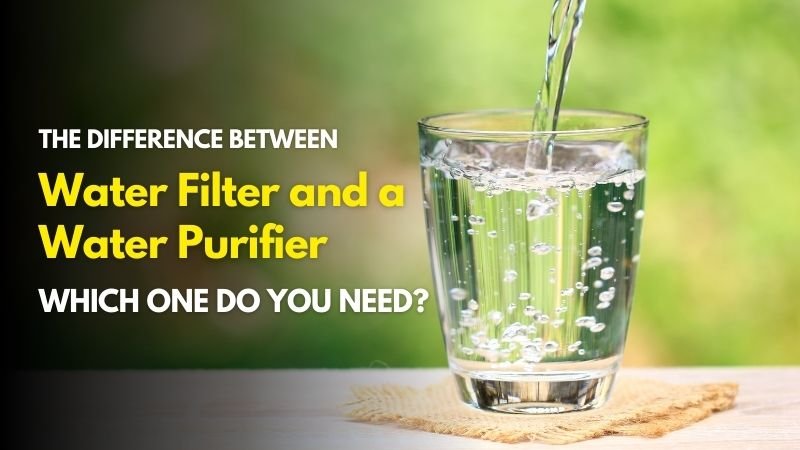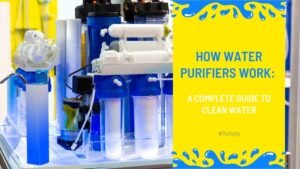In today’s world, access to clean and safe drinking water is crucial for maintaining good health and well-being. However, with the increasing levels of contaminants in water sources, it’s essential to understand the difference between water filters and water purifiers to ensure you’re getting the best possible water quality for your needs.
Why Clean Water is Crucial for Health and Well-being
Clean water is not only essential for hydration but also plays a vital role in maintaining overall health.
Consuming contaminated water can lead to various health issues, such as gastrointestinal problems, skin irritations, and even long-term health complications.
By understanding the difference between water filters and water purifiers, you can make an informed decision to protect your family’s health.
Understanding the Common Confusion Between Water Filters and Water Purifiers
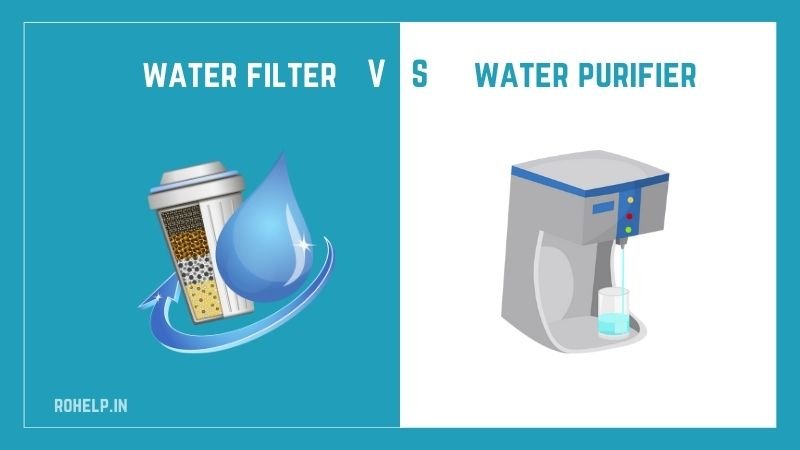
Many people often confuse water filters and water purifiers, thinking they are the same thing. While both aim to provide clean and safe drinking water, there are significant differences in their working mechanisms and the level of contaminants they remove.
What is a Water Filter?
A water filter is a device that removes impurities from water by physically trapping them in a filter medium. These filters work by creating a physical barrier that prevents contaminants from passing through, while allowing clean water to flow through.
How Water Filters Work
Water filters use various filtration methods to remove impurities from water, such as:
- Physical Barriers: These filters use a membrane or a filter medium with small pores that trap contaminants based on their size.
- Adsorption: Activated carbon filters use adsorption to remove contaminants by attracting them to the surface of the carbon.
- Ion Exchange: Some filters use ion exchange resins to remove dissolved ions, such as heavy metals, from water.
Different Types of Water Filters
- Activated Carbon Filters: These filters are effective in removing chlorine, taste, and odor from water.
- Sediment Filters: These filters trap larger particles, such as dirt, rust, and sand, preventing them from entering your water supply.
- Ceramic Filters: Ceramic filters use a physical barrier to remove contaminants, including bacteria and protozoa.
- Ultrafiltration (UF) Systems: UF systems use a semi-permeable membrane to remove contaminants, including bacteria, viruses, and some dissolved solids.
Common Contaminants Removed by Water Filters
Water filters are effective in removing various contaminants, such as:
- Dust, Silt, and Sediments: These larger particles can be removed by sediment filters.
- Chlorine and its Byproducts: Activated carbon filters are effective in removing chlorine and its byproducts, which can cause taste and odor issues.
- Heavy Metals like Lead: Some filters, such as those with ion exchange resins, can remove heavy metals from water.
What is a Water Purifier?
A water purifier is a more advanced system that not only filters water but also removes dissolved solids and microorganisms, ensuring a higher level of water purity. Water purifiers use various technologies, such as reverse osmosis (RO), ultraviolet (UV) treatment, and multi-stage purification, to remove a wide range of contaminants
How Water Purifiers Work
Water purifiers use advanced technologies to remove contaminants from water, such as:
- Reverse Osmosis (RO): RO systems use a semi-permeable membrane to remove dissolved solids, including minerals, salts, and heavy metals, from water.
- Ultraviolet (UV) Treatment: UV treatment uses high-intensity UV light to kill microorganisms, such as bacteria and viruses, without adding any chemicals to the water.
- Ultrafiltration (UF): UF systems use a semi-permeable membrane to remove contaminants, including bacteria, viruses, and some dissolved solids.
- Multi-Stage Purification (RO+UV+UF): Some water purifiers combine multiple technologies, such as RO, UV, and UF, to provide comprehensive water purification.
Common Contaminants Removed by Water Purifiers
Water purifiers are effective in removing a wide range of contaminants, such as:
- Dissolved Solids (TDS): RO systems can remove up to 99% of dissolved solids, including minerals, salts, and heavy metals.
- Microorganisms: UV treatment and UF systems can effectively remove bacteria, viruses, and protozoa from water.
- Pesticides, Chemicals, and Heavy Metals: RO systems can remove a wide range of organic and inorganic contaminants, including pesticides, chemicals, and heavy metals.
Key Differences Between Water Filters and Water Purifiers
The main differences between water filters and water purifiers lie in their working mechanisms, the depth of filtration, and the range of contaminants they remove.
Filtration vs. Purification
Water filters use physical barriers and adsorption to remove contaminants, while water purifiers use advanced technologies, such as RO, UV, and UF, to provide a higher level of water purity.
Depth of Filtration
Water filters typically remove larger particles, such as sediments and chlorine, while water purifiers can remove dissolved solids and microorganisms, providing a more comprehensive level of water treatment.
Efficiency in Removing Pathogens
Water purifiers, particularly those with UV treatment or UF systems, are more effective in removing microorganisms, such as bacteria and viruses, compared to water filters.
Suitability for Different Water Sources
Water filters are suitable for treating municipal water supplies with low levels of dissolved solids, while water purifiers are more suitable for treating water from wells, surface water sources, or water with high levels of dissolved solids.
Clean Water vs. Purified Water: What’s the Difference?
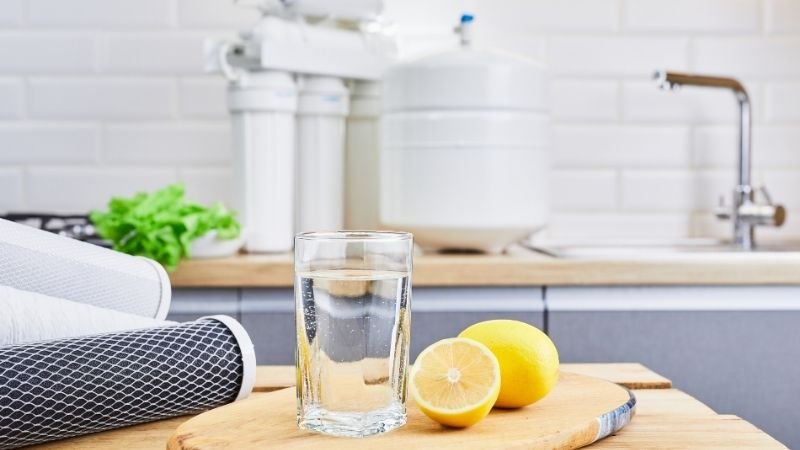
Clean water refers to water that has been filtered to remove larger particles, such as sediments and chlorine, while purified water refers to water that has undergone a more comprehensive treatment process to remove dissolved solids and microorganisms, ensuring a higher level of water quality and safety.
Understanding the Quality and Safety of Water
The quality and safety of water are determined by the levels of contaminants present in the water. While both water filters and water purifiers aim to provide clean and safe drinking water, water purifiers offer a higher level of water quality and safety by removing a wider range of contaminants.
Health Benefits of Purified Water Over Filtered Water
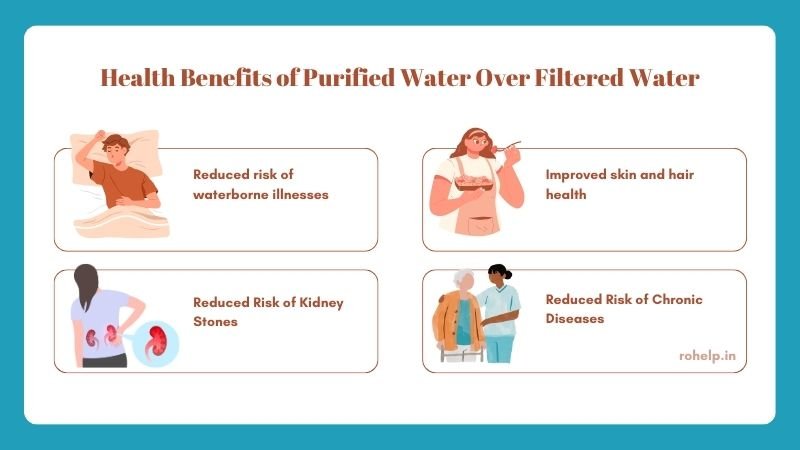
Consuming purified water can provide various health benefits, such as:
- Reduced risk of waterborne illnesses: Purified water is less likely to contain harmful microorganisms, reducing the risk of gastrointestinal problems and other waterborne illnesses.
- Improved skin and hair health: Purified water is less likely to contain chlorine and other chemicals that can dry out skin and hair.
- Better taste and odor: Purified water typically has a cleaner taste and odor compared to filtered water.
When Should You Choose a Water Filter?
Water filters are suitable for treating municipal water supplies with low levels of dissolved solids and when basic filtration is sufficient to meet your water quality needs.
Suitable Scenarios for Water Filters
- Municipal Water Supply with Low TDS: If you have access to a municipal water supply with low levels of dissolved solids, a water filter may be sufficient to remove contaminants such as chlorine and sediments.
- Situations Where Basic Filtration Suffices: If your water quality is generally good and you only need to remove basic contaminants, such as chlorine and sediments, a water filter may be a cost-effective solution.
Cost-Effectiveness of Using Water Filters
Water filters are generally more cost-effective than water purifiers, both in terms of initial costs and long-term maintenance. They also have lower energy consumption compared to some water purifiers, such as RO systems.
Pros and Cons of Water Filters
Advantages:
- Cost-Effective and Easy to Maintain: Water filters are generally less expensive and easier to maintain compared to water purifiers.
- Removes Basic Contaminants: Water filters are effective in removing basic contaminants, such as chlorine and sediments, improving the taste and odor of water.
Limitations:
- Doesn’t Remove Dissolved Solids: Water filters are not as effective in removing dissolved solids, such as minerals and heavy metals, compared to water purifiers.
- Limited Effectiveness Against Microbes: Water filters may not be as effective in removing microorganisms, such as bacteria and viruses, compared to water purifiers with UV treatment or UF systems.
When Should You Choose a Water Purifier?
Water purifiers are suitable for treating water with high levels of dissolved solids, the presence of harmful microorganisms, or when comprehensive water safety is required, such as in urban areas.
Suitable Scenarios for Water Purifiers
- High TDS Levels in Water: If your water source has high levels of dissolved solids, such as minerals and heavy metals, a water purifier with RO technology may be necessary to ensure safe drinking water.
- Presence of Harmful Microorganisms: If your water source is at risk of contamination by harmful microorganisms, such as bacteria and viruses, a water purifier with UV treatment or UF systems can provide effective disinfection.
- Need for Comprehensive Water Safety in Urban Areas: In urban areas, where water quality can be variable and the risk of contamination is higher, a water purifier can provide a higher level of water safety and quality.
Pros and Cons of Water Purifiers
Advantages:
- Effective Against a Wide Range of Contaminants: Water purifiers can remove a wide range of contaminants, including dissolved solids, microorganisms, and heavy metals, ensuring a higher level of water quality and safety.
- Ensures Safe Drinking Water: By removing harmful contaminants, water purifiers can provide safe drinking water, reducing the risk of waterborne illnesses.
Limitations:
- Higher Cost and Maintenance: Water purifiers are generally more expensive than water filters, both in terms of initial costs and long-term maintenance.
- Water Wastage in RO Systems: RO systems can produce a significant amount of wastewater, which may be a concern in areas with limited water resources.
Advanced Features in Modern Water Purifiers
Modern water purifiers come equipped with various advanced features that enhance user experience and water quality, such as:
- Smart Technologies: Some water purifiers use smart technologies, such as app connectivity and real-time monitoring, to provide users with information about water quality and filter life.
- TDS Controllers and Water Mineralizers: These features allow users to adjust the TDS levels in purified water and add back essential minerals, ensuring a balanced mineral content.
- Automatic Filter Change Alerts: Some water purifiers come with automatic filter change alerts, reminding users when it’s time to replace the filters for optimal performance.
Maintenance Requirements for Water Purifiers
Regular maintenance is crucial for ensuring the optimal performance and longevity of water purifiers. This includes:
- Importance of Regular Filter Changes: Filters should be replaced at regular intervals, as specified by the manufacturer, to maintain water quality and prevent the buildup of contaminants.
- Dealing with RO Water Wastage: RO systems produce wastewater, which can be minimized by using water-efficient models or by using the wastewater for other purposes, such as gardening or cleaning.
Comparing Costs: Water Filters vs. Water Purifiers
When choosing between a water filter and a water purifier, it’s essential to consider the initial costs, long-term maintenance costs, and energy consumption to make an informed decision.
Initial Costs and Installation
Water filters are generally less expensive than water purifiers, both in terms of the initial purchase price and installation costs. Water purifiers, particularly those with RO systems, may require more complex installation and have higher upfront costs.
Long-Term Maintenance Costs
Water filters typically have lower maintenance costs compared to water purifiers. Replacing filters in water filters is generally less expensive than replacing filters and membranes in water purifiers.
Energy Consumption Considerations
Water filters have lower energy consumption compared to some water purifiers, such as RO systems, which require energy to operate the RO membrane and pump.
Environmental Impact: Which is More Eco-Friendly?
When considering the environmental impact of water filters and water purifiers, it’s essential to look at factors such as water usage and the sustainability of filter replacement.
Water Usage in RO Purifiers
RO systems produce wastewater, which can be a concern in areas with limited water resources. However, some RO systems are designed to be more water-efficient, reducing the amount of wastewater produced.
Eco-Friendly Alternatives: Gravity-Based Purifiers
Gravity-based water purifiers are a more eco-friendly alternative to RO systems, as they do not require electricity or produce wastewater. These purifiers use the force of gravity to filter water through a series of filters, making them a sustainable choice for water purification.
Sustainability of Filter Replacement
When choosing a water filter or purifier, it’s essential to consider the sustainability of filter replacement. Some filters are designed to be more environmentally friendly, using materials that are recyclable or biodegradable.
Conclusion
In conclusion, both water filters and water purifiers play a crucial role in providing clean and safe drinking water.
The choice between the two depends on factors such as water quality, the presence of contaminants, and personal preferences.
Water filters are suitable for treating municipal water supplies with low levels of dissolved solids and when basic filtration is sufficient. They are cost-effective and easy to maintain, making them a good choice for many households.
Water purifiers, on the other hand, are suitable for treating water with high levels of dissolved solids, the presence of harmful microorganisms, or when comprehensive water safety is required. They offer a higher level of water quality and safety by removing a wider range of contaminants, but they come with higher costs and maintenance requirements.
When choosing between a water filter and a water purifier, it’s essential to consider factors such as water quality, the presence of contaminants, and personal preferences. By understanding the difference between the two and making an informed decision, you can ensure that you and your family have access to clean and safe drinking water.
Frequently Asked Questions (FAQs)
The main differences lie in their working mechanisms, the depth of filtration, and the range of contaminants they remove. Water filters use physical barriers and adsorption to remove larger particles, while water purifiers use advanced technologies, such as RO, UV, and UF, to remove dissolved solids and microorganisms.
Some water filters, particularly those with ceramic or UF membranes, can remove bacteria and protozoa. However, water purifiers with UV treatment or UF systems are more effective in removing microorganisms, including viruses.
If your municipal water supply has low levels of dissolved solids and the water quality is generally good, a water filter may be sufficient to remove basic contaminants, such as chlorine and sediments. However, if your water source has high levels of dissolved solids or the presence of harmful microorganisms, a water purifier may be necessary to ensure safe drinking water.
If your water source has high levels of dissolved solids, such as minerals and heavy metals, or if you live in an area with poor water quality, an RO water purifier may be necessary to ensure safe drinking water. RO systems are effective in removing a wide range of contaminants, including dissolved solids, heavy metals, and microorganisms.
RO systems produce wastewater, which can be a concern in areas with limited water resources. However, some RO systems are designed to be more water-efficient, reducing the amount of wastewater produced. Additionally, the energy consumption of RO systems may be higher compared to other water purification methods.
In urban areas, where water quality can be variable and the risk of contamination is higher, a water purifier is generally better suited to provide a higher level of water safety and quality. Water purifiers can remove a wider range of contaminants, including dissolved solids, microorganisms, and heavy metals, ensuring safe drinking water for urban residents.

